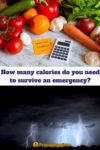Even though you probably consume between 2,000 and 3,000 calories daily, you could survive on half that.
Many enthusiastic dieters drop their daily calorie intake to between 1,200 and 1,500. This quantity is enough to keep the average person’s body and mind functioning but can still negatively impact that person’s general health if sustained for more than a few days.
Of course, everybody’s different, and some people need more calories than others to prevent their bodies from going into starvation mode.
As nutrition expert and spokesperson for the British Dietetic Association, Ursula Philpot points out, saying that everyone can survive on 1,200 calories a day “is like saying all men should wear size 9 shoes.”
You might be able to survive on less than 1,200 calories a day if you’re sitting around the house watching Netflix. You’ll burn a lot more if you’re stuck out in the wilderness, worrying about your future and struggling to survive.
How We Burn Calories Changes in an Emergency
Stress affects how our bodies produce insulin and adrenaline. Our pulse rate increases, and we become tense and may struggle to sleep. All these changes require energy, which we need to supply in the form of calories.
Physical changes also occur when we’re under stress, affecting the calories we need to consume.
There are four different ways our bodies burn calories:
- The Basal Metabolic Rate (BMR) is the number of calories our bodies need to maintain vital functions, such as breathing, brain function, and heart rate
- The Thermic Effect of Food (TEF) is the total number of calories we burn while digesting food. This is usually around 10% of your calorie intake
- Thermic Effect of Exercise (TEE) covers the calories we burn through physical activity
- Non-Exercise Activity Thermogenesis (NEAT) refers to the calories we burn subconsciously fidgeting and changing position
The amount of calories we consume through these four processes varies. Hormonal changes, for example, can reduce or increase the number of calories we need, as can stress and changes to the nervous system.
In a survival situation, we’re likely to burn more calories than we do at home and yet have fewer calories available to keep our bodies functioning.
Rather than recommending the minimum calorie intake of between 1,200 and 1,500 per day, the US Food and Drug Administration advocates storing the following quantities of survival food:
Children: 1,000 to 2,000 calories per day
Adult women: 1,600 to 2,400 calories per day
Adult men: 2,000 to 3,000 calories per day
Ideally, these calories should come from foods that balance nutrients, protein, carbohydrates, and fiber.
Unfortunately, many so-called emergency foods fail to offer such a balance and could leave you suffering a calorie deficiency.
MREs, for example, contain high levels of fat and sodium but not so much in the way of carbohydrates and fiber. You can find out more about whether MREs are healthy.
Eating Too Little Can Endanger Your Health
Even if you’re eating 1,200 calories a day, you’ll suffer the consequences if you’re not getting the vitamins and minerals your body needs.
A lack of iron, for example, could cause anemia, while a niacin deficiency could put you at risk of a heart attack, and a reduced zinc intake could cause your hair to fall out.
Many emergency foods are heavily processed and contain high levels of sugar and salt. While these will temporarily keep your energy levels up, they won’t give you the nutrients your body needs to function. As a result, you may start to feel dizzy or light-headed. Your blood pressure may also drop, making it difficult to think clearly.
Some people’s bodies enter starvation mode long before their consumption drops to survival levels.
If calorie consumption drops too low, your metabolism slows down to compensate. It preserves the available calories for vital functions like blood circulation and breathing. When your body enters starvation mode, you may feel lethargic, have trouble concentrating, or feel weak and cold.
To survive in chilly winter temperatures, you need calories to burn for heat and fuel. If you don’t get enough, you put yourself in danger of developing hypothermia.
What To Eat If You Want To Survive
Water is the most vital factor in any survival diet and is included in all the best pre-made bug-out bags.
The Federal Emergency Management Agency (FEMA) suggests that you can get by on as little as 64oz of water a day, although the US Coast Guard recommends that if water is extremely scarce, you can survive on as little as 4.225 oz per day.
Other studies, however, indicate that this applies only to healthy adults who live a largely sedentary existence in a temperate climate.
If you’re outside, surviving on your wits and bug-out bag, you’ll need a larger fluid intake, especially if you’re in a hot climate and want to prevent disease.
While survival food bars will keep you going, a quick look at their nutritional facts will soon reveal their shortcomings.
According to the results from the US Department of Agriculture’s Dietary Reference Intakes Calculator, we should consume four times as much carbohydrates as fat.
The best survival foods, therefore, are calorie-dense and high in carbohydrates. Survival bread, like hardtack, may contain little more than flour and water, but flour is so calorie-dense and high in carbohydrates that it provides much of the energy we need.
Our survival food list gives a clearer idea of what you need to stockpile for an emergency and includes:
- Canned meat and vegetables
- Peanut
- Crackers
- Dried fruit
- Granola bars
- Instant mashed potatoes
- Oatmeal.

Emergency Food Binder
If you need help with your emergency food storage plans, we sell an Emergency Food Planning Binder, which includes a workbook, inventory sheets, and a spreadsheet to calculate and track the correct amount of food for your situation. Read more about it here.
How To Calculate Calories For Survival
If you multiply your current weight by 15, this will give you the number of calories needed to maintain your current weight, assuming you’re moderately active and not lounging on the couch.
You can get a more accurate idea of your daily nutrient requirements by using an online calculator. I used the one provided by the US Department of Agriculture, and according to the results, as a 5’4″ woman who weighs 140 pounds, I should consume 2,289 calories per day. This amount is a little more than the equation above stated, which was just 2,100 calories, but it’s close enough.
Carbohydrates comprise the lion’s share of those calories, vital energy sources that help fuel our bodily functions. Fat, protein, and fiber are also crucial but are often absent from pre-packaged survival foods.
If I were to drop that down to 1,200, I’d easily survive for a few days without any nasty consequences. After that, however, I would probably start to feel lethargic and struggle to maintain the energy levels needed to survive.
Conclusion
Bugging out is a potentially stressful and physically demanding experience. 1,200 calories may not be enough to compensate for the energy you expend in a survival situation.
Consuming too few calories compromises your normal bodily functions. It could cause you to feel lethargic and light-headed. It could also increase your risk of hypothermia in cold conditions.
The right balance of carbohydrates, protein, fat, and fiber is also crucial to your survival and well-being.


